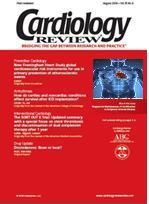Publication
Article
Cardiology Review® Online
Can reduction in electrocardiographic left ventricular hypertrophy be helpful in preventing clinical heart failure?
Author(s):
As clinical cardiologists, we face an ever-changing landscape with regard to the management and care of hypertensive patients.
As clinical cardiologists, we face an ever-changing landscape with regard to the management and care of hypertensive patients. One particular challenge is the prevention of end-organ manifestations of hypertension, namely stroke and heart failure. With a lifetime risk of 20% for developing congestive heart failure in the general population, the need for prevention, as well as treatment strategies to address the progression of heart disease, seems a very high public health priority. Traditional preventive efforts include serial blood pressure readings (as a tool to direct both drug and mechanical therapies such as renal artery stenting), which can help prevent catastrophic end-organ results. Although this approach in theory should be sufficient, very often it lacks the accuracy and reliability necessary to direct true aggressive treatment strategies. Another commonly used screening tool is the 12-lead electrocardiogram (ECG), a standard and widely available technology used in both outpatient and inpatient settings. The utility of this clinical tool is examined in the paper by Glasofer and Okin.
In their study, the authors investigate the relationship between reduction of electrocardiographic left ventricular hypertrophy and hospitalization for new-onset heart failure. This multicenter cohort study was derived from data collected during the Losartan Intervention For Endpoint reduction in hypertension (LIFE) study. The LIFE trial was a double-blind, randomized trial comparing morbidity and mortality with the use of losartan versus atenolol-based antihypertensive therapy in 9193 patients with essential hypertension and electrocardiographic evidence for left ventricular hypertrophy. After 714 patients were excluded from the study group due to either preexisting heart failure or lack of a complete set of initial and follow-up ECGs, the study was left with 8265 hypertensive patients requiring hospitalization who did not develop heart failure versus 214 who entered the hospital with a new diagnosis of heart failure. As expected, there was a high proportion of patients in the heart failure group with diabetes, ischemic heart disease, prior myocardial infarction, atrial fibrillation, and renal insufficiency. In addition, the heart failure patients were older (70.7 years versus 66.7 years), and smoked more. Cholesterol status, sex, and ethnicity were not significant characteristics of the heart failure group.
Electrocardiographic reduction of left ventricular hypertrophy was assessed using the Cornell voltage-duration product and the Sokolow-Lyon criteria, both fairly standard indexes. Electrocardiograms were performed at baseline, 6 months, and then annually for a mean of 4.7 years in this study.
The significant results of this trial can be summarized as follows. Using Kaplan-Meier curve analysis, it was found that a reduction of more than 236 mm·msec in the Cornell product on serial ECGs was associated with an absolute decrease in the incidence of new-onset heart failure (1%) after 4 years. After adjusting for the possible effects of baseline ECG differences, patient characteristics, in-treatment blood pressure changes, and varying treatment regimens, a greater than 236 mm·msec decrease in the Cornell product remained associated with a 36% lower risk of new heart failure. It should be noted that these analyses were also done using the change in Cornell product as a time-varying continuous variable.
The take-home clinical messages from the study are many, and offer new possible insights into the management of hypertensive patients with varying numbers of comorbidities for cardiac disease. First, the use of the 12-lead ECG has been shown to be a powerful tool in monitoring patients with essential hypertension and directing management strategies. Patients meeting the Cornell criteria for left ventricular hypertrophy could be considered candidates for very aggressive pharmacologic or mechanical treatment of their hypertension early on, in the hope that heart failure onset can be prevented. Remember that as our patient population ages, there are more contraindications to various drug regimens in hypertension management. The Cornell criteria for left ventricular hypertrophy by serial ECG assessment may aid in medical decision making in these high-risk patients in whom treatment options become limited. The finding that a reduction of the Cornell product for left ventricular hypertrophy on these patient's ECGs is associated with fewer hospitalizations for heart failure, independent of blood pressure lowering and other risk factors, is very powerful in managing patients in the clinic setting.
The limitations of this study from the clinician's standpoint primarily revolve around the use of hospitalization for new-onset heart failure as the study end point. This will, understandably, underestimate the incidence of new-onset heart failure that may be significant but not mandate hospitalization at the time of diagnosis.





